Have you ever wondered what a successful Facebook ad looks like?
Sure, you can browse your Newsfeed to find ads with great engagement.
But let’s be honest, you don’t get the full picture.
Now I don’t want you to get overwhelmed but there are a lot of elements involved in creating a profitable Facebook ad.
Below, I’ll break down all the parts that need to come together to create an ad that can generate six-figures in sales using an example from one of my previous stores.
Here’s What We’re Covering:
- Part 1: The Product
- Part 2: Experimentation
- Part 3: The Photo
- Part 4: The Copy
- Part 5: Targeting
- Part 6: The Strategy
- Bonus Ideas to Drive More Online Sales
- Wrapping this up…
Part 1: The Product
In the past six years, I’ve built countless online stores. I’ve dabbled in niches like home decor, pets, and even bridal. But none of those stores had the runaway success that my yoga store had.
The funny thing is our best-selling product at the time wasn’t a yoga product at all. It was a beach blanket.
Be willing to think outside the box
Now, you might think that since our best-selling product was a beach blanket, we could just sell other styles to skyrocket our sales growth. But the data clearly shows that this couldn’t be further from the truth.
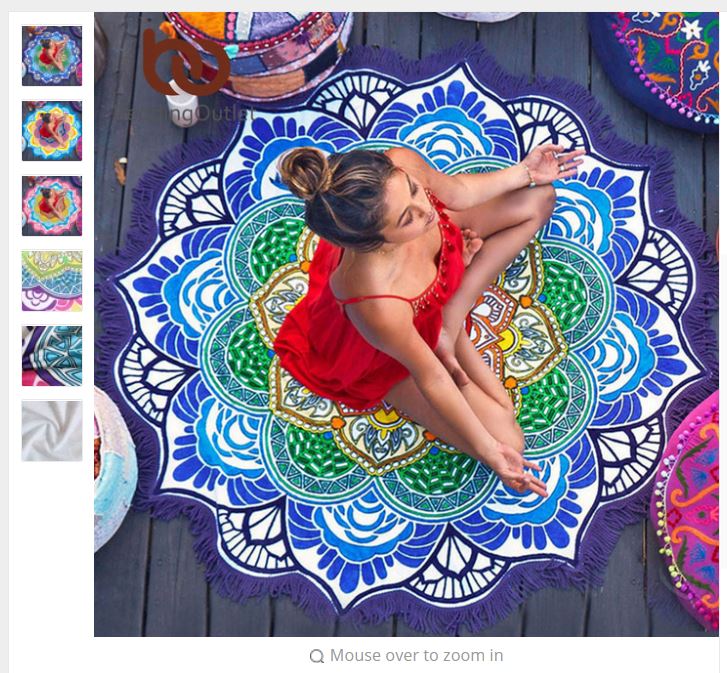
Our best-selling product generated over $253k net sales (minus ad costs) and our second runner-up only brought in about $30k. Nowhere near close.
The secret to creating a successful Facebook ad first requires you to find and sell the perfect product.
So, what does the perfect product look like?
- It compels the impulse buy (especially a must for Facebook ads)
- Product photo has a color vibrancy that pops when scrolling
- The product has an element of escapism to it (for us it was a product that helped you imagine yourself relaxing)
- It’s reasonably priced at market value but also allows affordability when purchased in bundles
- It’s hard to find at a local retailer giving you a competitive advantage in marketing online
- The product needs to tap into a passion or a lifestyle with a large audience
- If the product is ‘Instagrammable’ as in your customers can take photos of your products and share on social media, it’ll likely have a bigger reach
Of course, there are other elements that could play a part in finding that winning product. This is just one example of what’s worked for me.
Now here’s where it gets tricky:
You could very well have stumbled onto the perfect product and have no idea. Here’s a screenshot of my store’s first month’s sales.

I mean $1,600 in a month isn’t bad for a brand, spankin’ new online store. But it’s nowhere near obvious that our store had a six-figure product on it.
The real reason I’m sharing this leads us to our next part: experimentation.
Part 2: Experimentation
You’ll never know if you have a winning product in your store unless you experiment.
To get to the point where we had a successful Facebook ad, we first had to create countless unsuccessful ads.
That means creating ads for the wrong product, targeting the wrong audience, and writing copy that just didn’t work.
Truth is, we created dozens of failed ads before hitting our home run.
I could lie to you and tell you that I’m a brilliant Facebook marketer who consistently creates home run ads every time I create I open up my Ads Manager.
Reality is, there’s a lot of upfront work that most “experts” don’t talk about when it comes to creating a successful Facebook ad.
So let’s break down what our best performing Facebook ad looked like so you have to do a little less experimentation when running ads on your store.
Shopify is giving readers a FREE 14 Day Trial to create an online store!
Get The FREE 14 Day Trial
Breakdown of Our Most Successful Facebook Ad
Well, first here it is…
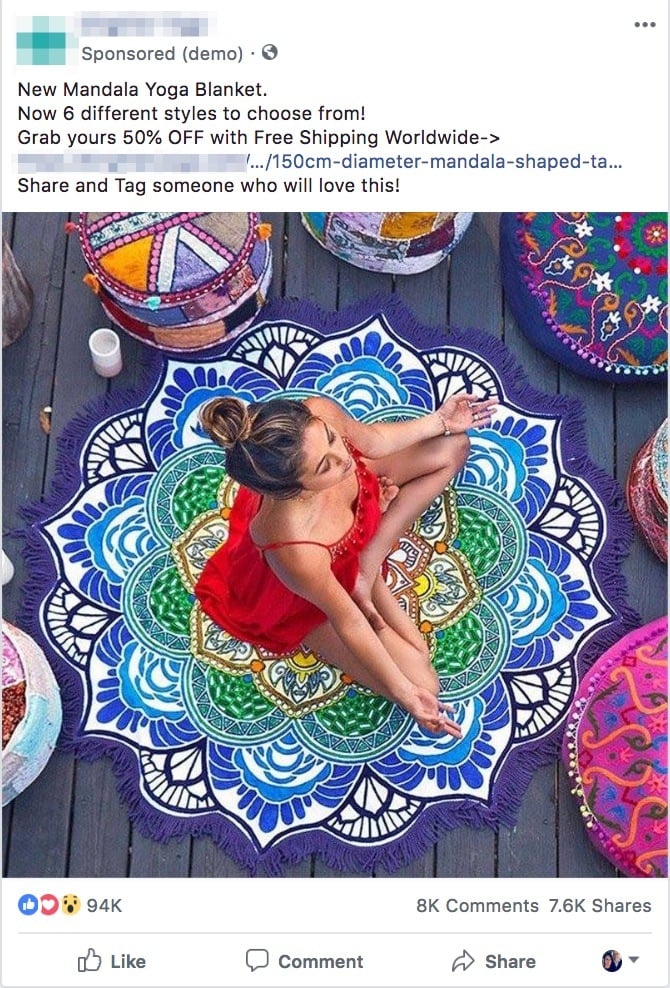
94k likes, 8k comments, 7.6k shares, Relevance Score of 7 and over $110k in sales (for this specific ad).
Now let’s break down every part of this ad.
Part 3: The Photo
We imported this product from AliExpress via the Oberlo app so we can’t take credit for the picture.
But here are a few noticeable aspects of the picture:
- The product in the photo, along with the seat cushions, are colorful. There’s also that pop of red that captures your attention with the woman’s dress. Every successful ad I’ve ever created has the color red in some sort of capacity. Mostly because red captures attention better than any other color.
- Most people aren’t used to seeing photos from an aerial view. Usually, photos are taken from the front. The rare perspective results in someone noticing the picture since it’s different from what you normally find in lifestyle photos.
- Look at how relaxed she looks meditating on her porch. Having a photo like this makes escapism look easy for the consumer. You can find peace of mind in the comfort of your own home. This picture illustrates this feeling perfectly.
- The woman in the picture also looks like she is in her twenties. Not surprisingly, this ad performed best for women between ages 25-34. It’s likely that women felt like they could relate to the woman in the photo due to proximity in age. You can’t clearly see the woman’s face which makes it a bit easier for you to imagine yourself relaxing on a beach blanket like this.
We tried running ads to different pictures of the same product but this photo was the clear-cut winner.
Part 4: The Copy
It’s true that when you have a great picture it does most of the heavy lifting for landing those sales. However, we still made an effort to write copy that would help with conversions.
With a strong copywriting background, I sometimes over think my copy. I try too hard to make it sound good.
So I used a tool called FB Search to look at the ad copy of competitors within my niche. It only shows you ads that were created as existing posts however, existing post ads tend to be pretty popular.
As a result, I mashed up a few ad templates from highly engaged ads within my niche.
Breakdown Of The Ad Copy

It clearly states what the product is. Sometimes pictures don’t clearly tell you what the product is and communicating this in the ad helps a customer understand what they should buy.

We mentioned that there were other styles to help entice people into visiting our website to check out other styles.

Market value of these products was actually about double what we were charging for. So we were able to put a retail price that was double our cost while still affordably charging half the price of the product. Since we were dropshipping these beach blankets we were able to offer free shipping worldwide using ePacket.
Normally, ePacket is only a couple of dollars but for our product it was actually free so it didn’t cost us anything to offer free shipping.
We actually used the full url link instead of using a link shortener which made the link more visible to the consumer to entice the click.

Asking for shares and tags was really common in ads when we first created this ad. As you can see by the 8k comments and 7.6k shares, asking for shares and likes actually does help get more engagement on the ad. This likely also helped us get a 7 Relevance Score since people were not only buying from the ad but engaging with it as well. Unfortunately, asking for friend tags on Facebook is now not acceptable on ads.
Part 5: Targeting
Now let’s break down the part of the ad that people don’t get to see: the targeting options.
Conversion Event Location
We optimized this Facebook ad for Purchase. However, it’s hard to optimize an ad for purchases if you’ve never had a sale before.
A trick we did to get our first few sales involved creating blog content that featured niche influencers. This strategy is to warm leads up with content to then retarget them with sales ads.
- Since we were in the yoga niche, I’d create an article called “10 Inspiring Quotes from [yoga influencer]”
- I’d then create quote graphics and add the influencers best quotes.
- Then, I’d tag them on Twitter mentioning that we created an article of their best quotes. Since these influencers often had fan pages of people who were devout followers, they’d share it with their audience.
- We made sure to have a Facebook retargeting ad running before reaching out to the influencers. We had this product shown in the retargeting ad and got our first few sales this way.
The audience was highly targeted since they were all yoga enthusiasts and so we’d get a steady stream of free qualified traffic with this strategy.
Benefit of Creating Custom Audience
Because we did that to get our first few sales, Facebook had data of what kind of customer would buy this product allowing a Purchase ad to work well. We were really careful to try to get our exact audience so it wasn’t about just getting traffic to our website but to get qualified traffic from people who were clearly enthusiastic about our niche.
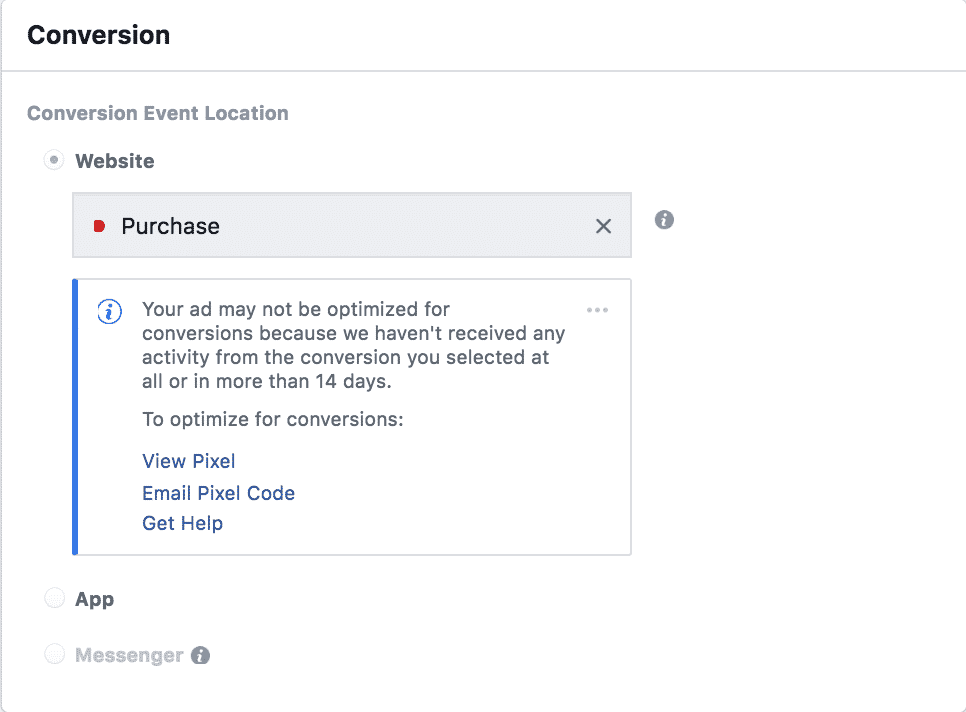
If you try creating a Purchase ad without having any purchases makes it difficult to get sales. When I don’t follow my strategy for getting my first few sales the way I mentioned above, I usually end up with a poorly performing Purchase ad.
Locations, Age, Gender, and Detailed Targeting
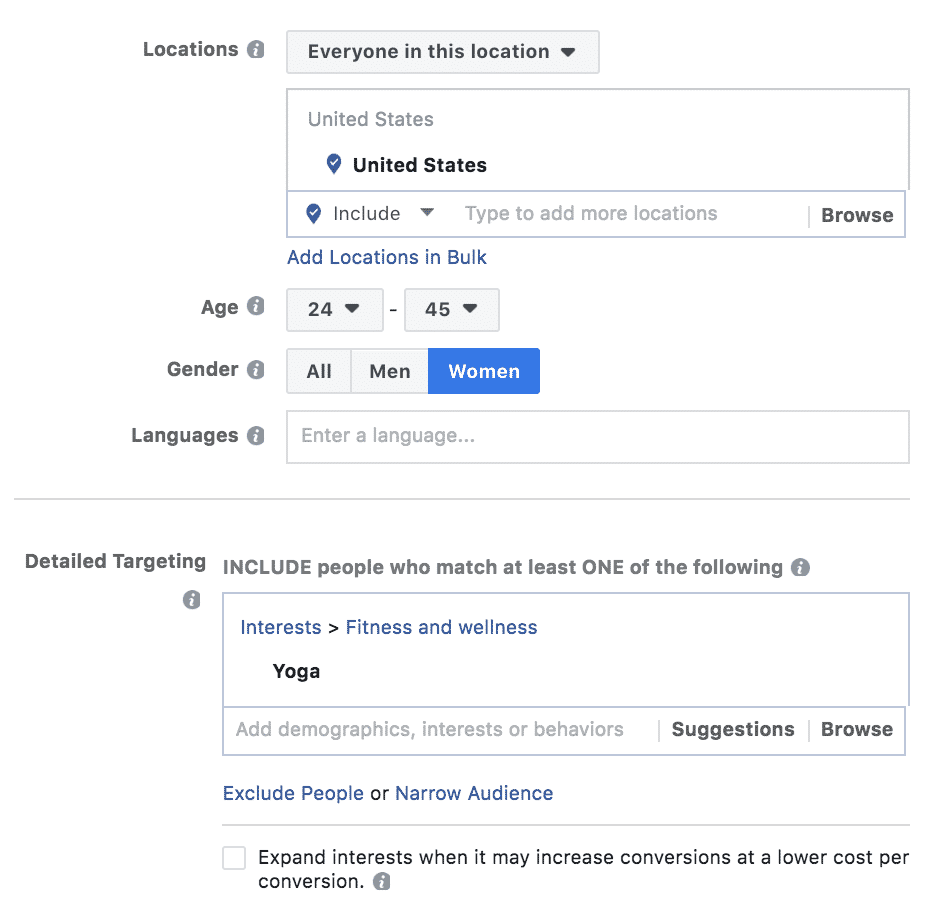
I know, I know, this ad probably looks basic. But hey, sometimes basic works well.
Location:
In the past, we’ve tried running Worldwide ads and they worked well. When running a Worldwide ad to this product, we ended up getting a ton of sales from a country called Jersey. So we learned a bit about geography, but in the end that audience got exhausted quickly. And it cost us more money than it made.
So we did what everyone else does. We targeted the United States. With 325.7 million people in the country, the audience size is clearly big enough to not be exhausted right away.
Age:
For the age group, we targeted ages 24-45 with the 25-34 age group dominating the sales. We chose that age group because we wanted to target people with expendable income. We figured that people in that age group likely have full-time salaried jobs that can help them afford a lifestyle product like this one.
Gender:
We chose Women as the gender because all of our experimental ads proved that this was just a powerhouse of an audience when it came to purchases. We rarely had men buying these products so we just went all in with this gender.
Interests:
For interests, we chose yoga. Mostly because our domain name included the yoga keyword in it. And we figured that they’d be the main consumers of this product. I know, it can look a bit basic to have just one general keyword taking up an ad. However, the yoga audience size on Facebook includes over 185 million people. Massive. Making it a great audience to tap into just because it’d be really hard to exhaust this audience quickly.

We didn’t try to do anything fancy or gimmicky just to make us seem like we were some fancy advanced Facebook guru. We just stuck to the basics of the tried and true. And you know what? It worked.
Placements
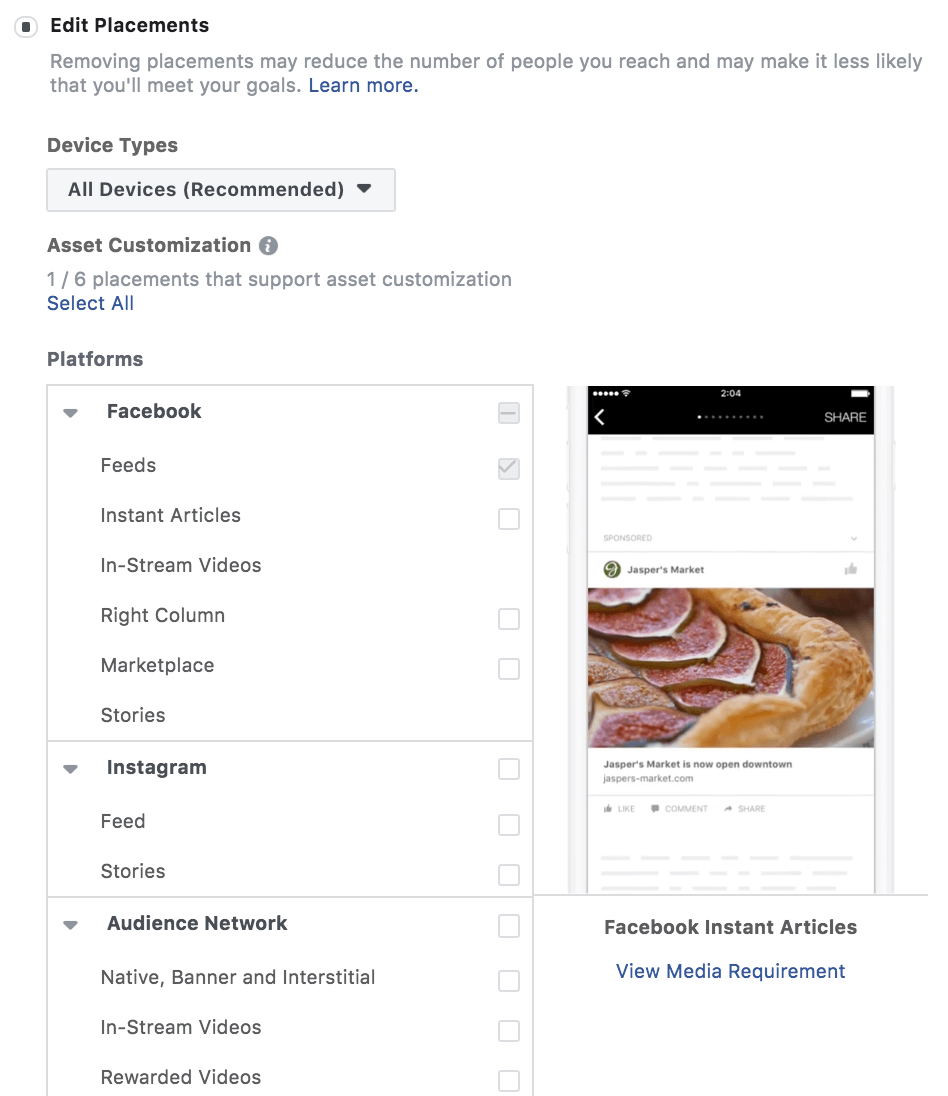
For placements, we also stuck to what normally works for us: Facebook Feeds.
Prior to creating this ad, we found that other ad placements failed to deliver the same level of sales as Feeds placements had. Plus, having the ad placed on the Newsfeed allowed for greater visibility for an impulse buy product.
Any other placement would simply be too small to really show off the product in all its glory. Also, keep in mind, that when we first created this ad some of the targeting options below weren’t available to us, such as Instagram Stories.
Part 6: The Strategy
For this ad, we used an existing post. The upside to this is that it helps gives social proof when people find your ad scrolling through your Facebook page. The downside to this is that anyone can see your ads – even your competitors.
Still, we figured that using an existing post would help us more than it would hurt us.
To get a high level of engagement to this ad, we did two main tricks:
a) First Run an Engagement Ad
When you’re just starting out, having an engagement ad run to your existing post ad helps skyrocket the level of engagement on your post.
Why do this? Social proof.
By showing how many people like this product, it helps entice other people who could like the product to buy. The engagement ad won’t usually convert into sales so if you’re on a tight budget, you might choose just to stick to purchases. However, if you’re looking to create a more viral effect on your ad on a product that you know will perform well, this can help give that ad a bit of a boost.
b) Direct All Your Ads to the Same Post
The second strategy to boosting conversions and social proof is to direct all your ad traffic to the same post.
I mentioned earlier that you should experiment. So if you’re experimenting with different targeting options you can still direct all the traffic to one ad. And that’s what we did.
We would create Worldwide ads minus Canada, US, Australia and UK but they’d see the same ad as the American demographic. This also helped increase engagement on the ad. While engagement doesn’t necessarily lead to sales (I learned that the hard way) it does give more social proof to an ad that does compel an impulse buy.
Bonus Ideas to Drive Online Sales
Bonus #1 – Optimize Product Landing Page with a Countdown Timer
You can create the best ad in the world but if your landing page isn’t optimized, you won’t get the sale. We added a countdown timer to help compel the purchase for our impulse buy product. When we removed it our sales completely stopped. Now, Shopify has changed their policies to help make countdown timers a bit more ethical.
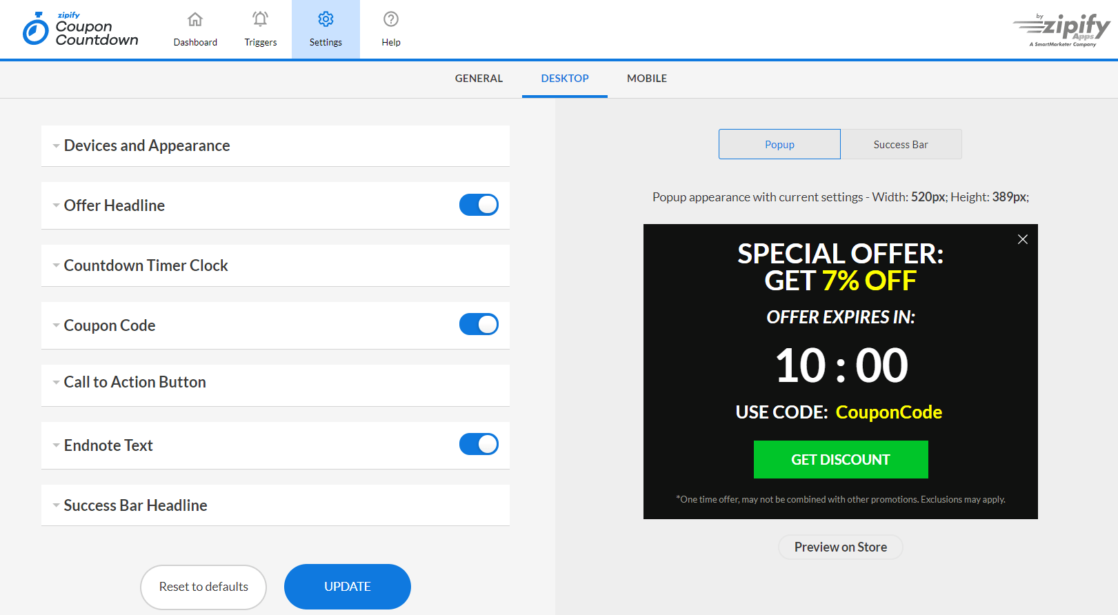
Ezra Firestone of Zipify pages offers an ethical countdown timer that’s compatible with Shopify that offers an expiring coupon. But a simple way to add countdown timers to your strategy is just to host holiday sales, or special sales on your best performing weekdays so that you can use it without being deceitful.
Trick #2 – Bundle Product Offerings Together
Since we knew that people loved the products we’d bundle them in 3-packs so that people can buy other styles or for friends affordably. This worked surprisingly well and kept our average order value high to help make our ads a bit more profitable.
Trick #3 – Always Run a Retargeting Ad
We always had a retargeting ad running in the background. This allowed us to warm up first time visitors if they weren’t ready to buy when they first saw the ad. Our retargeting ad was one of our top performers.
Wrapping this up…
When it comes down to generating $253k worth of sales with a successful Facebook ad, it’s not just about the ad content alone. You also have to consider what you’re selling and what the landing page looks like.
Of course, you can still have a big impact by creating a well-crafted ad that’s optimized for conversions using some of the strategies and examples I mentioned. However, it’s important to think of your ad as one part of a bigger process rather than as the main driver of sales. By carefully considering all the components of the process, you can create an ad that not only converts but generates a substantial profit for your business.
Leave a comment below and let’s keep the conversation going!
Shopify is giving readers a FREE 14 Day Trial to create an online store!
Get The FREE 14 Day Trial

Madam I really enjoyed this lecture. It’s really helpful thank you.
Thanks for reading the article!
Interesting, I’ve got a drop shipping biz that I cant seem to get to take off. Did about $17k last year but it’s mainly a tripwire product
How was the 250K in purchase revenue attributed? Is this based on Facebook’s standard 28-day click and 1-day view?
That is amazing. I have been around a longtime and you really know your stuff,